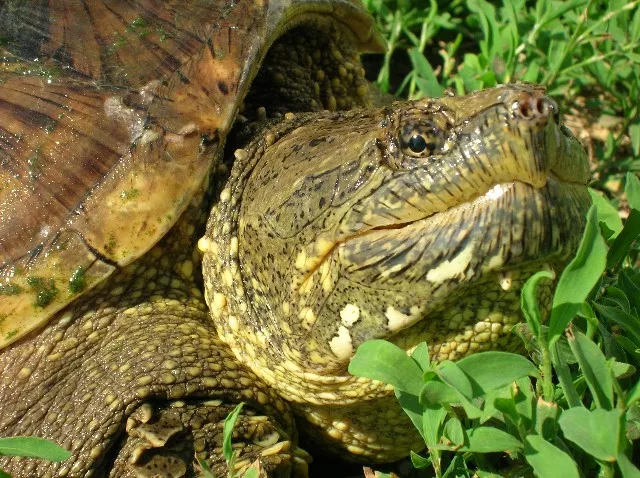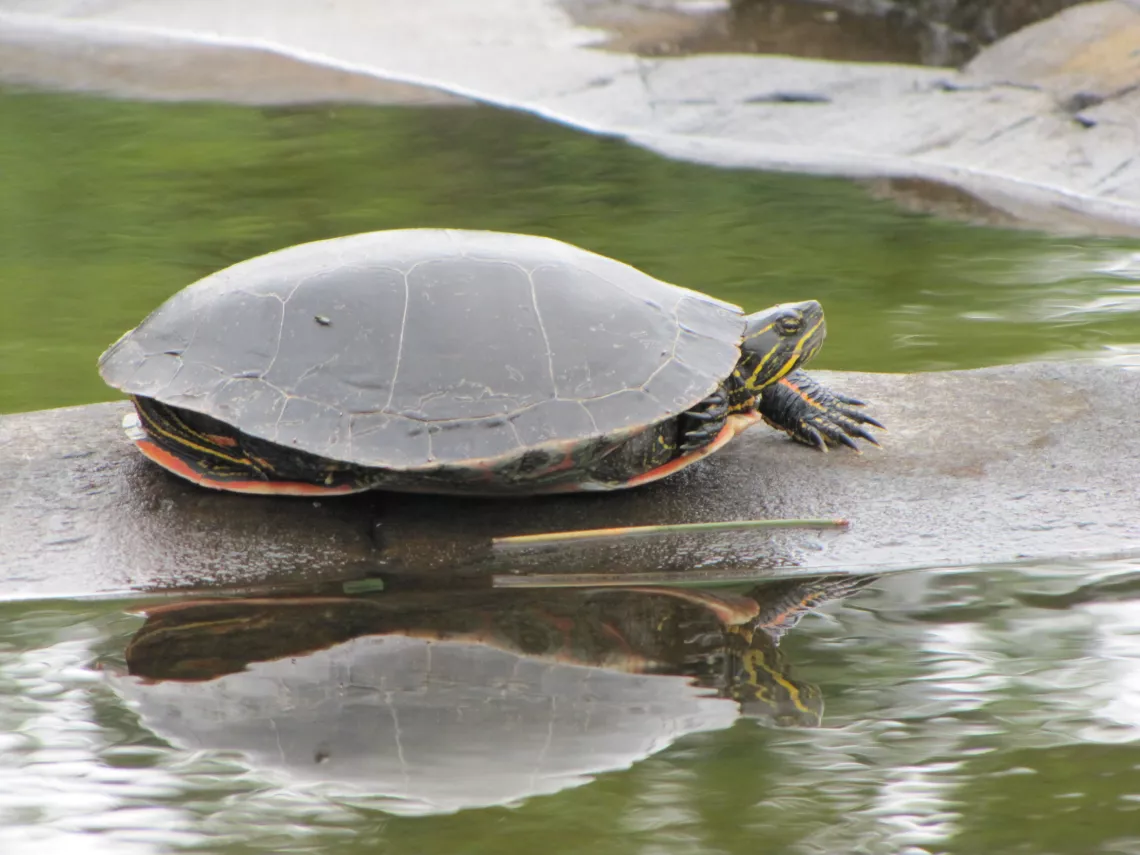Rules for turtle season and possession limits finally approved
The Iowa Department of Natural Resources (DNR) received final approval of rules that restrict the commercial and sport trapping of turtles, including daily catch and possession limits. That approval was given by the Administrative Rules Review Committee, a joint committee of the Iowa legislature on March 10, 2017.
The rules close the sport and commercial trapping of turtles between May 15 and July 15, for the 8 weeks during the primary nesting season, for painted and softshell turtles; the same season applies to the commercial harvest of snapping turtles. For the commercial trapper, the rules also set a daily catch limit of 4 common snapping turtles and a possession limit of 20, a daily catch limit of 1 painted turtle and a possession limit of 5, and a daily catch limit of 1 softshell turtle (either smooth or spiny) and a possession limit of 5 softshell turtles. Sport trappers have the same daily catch limits as commercial trappers; sport trappers can possess up to 100 pounds of live turtles or 50 pounds of dressed turtles.
The Chapter supported the daily catch limits and the possession limits, but would prefer a shorter harvest season that would allow the turtles to nest and reproduce. Ideally the season should be closed from January 1 through July 15.

Photo courtesy Mark Rouw.
Saving Iowa’s Wild Turtles
Turtle populations are declining due to over-harvest and harvesting during the breeding and egg-laying months. Additionally turtles face challenges due to nest predation, habitat loss, water pollution, collisions with automobiles as the turtles move from and to nesting sites, flooding which inundates nesting sites and droughts which dry the wetland habitat required for the turtles. Most of the turtles that are commercially trapped are sent to overseas markets, mainly in Asia.
The good news: The turtle populations can increase their populations to a more sustainable level with a closed season that corresponds with the breeding and nesting season.
The bad news: Once the turtles have been removed from a water body, turtles have great difficulty re-establishing their populations.
Background on Rule for a Turtle Season and Bag Limits
On March 23, 2016, the Governor signed a law that would require the Iowa Department of Natural Resources to establish a season and bag limits for commercial and sport trapping of turtles in Iowa. The bill number was HF2357. The Iowa Department of Natural Resources was given responsibility for setting the season and bag limits. The species affected are the painted turtle, smooth softshell turtle, spiny softshell turtle, and snapping turtle (although sport trappers will not face a season on snapping turtles). Furthermore, the Department of Natural Resources will be required to submit a study of the turtle populations to the Iowa legislature by January 1, 2021.
Ensuring a Sustainable Harvest
The Iowa Chapter supports closing the season for trapping turtles during their reproductive season. Ideally the season should be closed from January 1 to July 15. By closing the harvest of turtles from January 1 through July 15, turtles will be able to sustain their populations at current levels or increase their current populations, while allowing some turtles to be harvested. The season should be closed for both male and female turtles. Unfortunately the rules closing the season for 8 weeks during the prime egg-laying weeks are not adequate to protect the turtles during their breeding season.
The on-going population health is fragile and could easily result in over-harvest if adequate and proper monitoring is not pursued. Consequently the Iowa Chapter supports annually monitoring the populations of the four commercially harvested turtle species to determine appropriate numbers allowed for harvest. The Chapter also supports authorizing the Iowa Department of Natural Resources to close the season for any turtle species that faces population declines.
A harvest is considered sustainable if the population of turtles is able to maintain its population, or even grow its population, allowing the turtles to continue to live in Iowa's waters for generations to come. The turtle harvest is not sustainable if it results in declining populations. Likewise the harvest is not sustainable if there is a risk that the turtles will be extirpated from the waters in Iowa. Turtle trappers call the turtles a renewable resource. However the resource is not renewable if the populations cannot sustain themselves. The resource is not renewable if the turtles have vanished from the water bodies where they have traditionally lived.
Turtles Belong in Iowa
Let’s ensure that turtles are able to live sustainably in Iowa’s rivers and lakes!
To review documents related to the effort to protect Iowa's turtles, see the items posted below:
See the Iowa Chapter's comments about the rules approved by the Governor
Rules approved by the Governor, September, 2016
Protecting Iowa's Wild Turtles fact sheet
Chad Dolan, biologist, Iowa Department of Natural Resources, presentation on turtles made September 17, 2015 to Iowa's Wild Turtle Working Group
2016 proposed rules, package presented to the governor in summer of 2016
Iowa Chapter comments to the DNR about proposed season, daily catch limits, and possession limits, June 2, 2016
See the presentation made by the Sierra Club at the September, 2015, Wild Turtle Working Group meeting, in powerpoint format or in PDF format.
Materials DNR sent to Governor Branstad February 12, 2015
Letter Sierra Club sent to the Department of Natural Resources, February 14, 2014
About the Natural Resources Commission
The Sierra Club also is advocating for:
- Funding on-going field studies, including monitoring the populations
- Being prepared to close the season or to significantly restrict the quantity of turtles or the pounds of turtles that can be harvested, should studies indicate that a species is facing serious population declines
- Continuing the reporting required from commercial harvesters
- Surveying the sport trappers similar to the bow hunter survey
- Increasing the number of streams and lakes where turtles are tested for toxins (such as mercury) to ensure that the meat is safe for human consumption

Photo courtesy Ray Harden.
Biodiversity hotspot
Protect the Turtles in the Southeast Iowa Amphibian and Reptile Conservation Area
The Southeast Iowa Amphibian and Reptile Conservation Area is a biodiversity hotspot for amphibians and reptiles - frogs, toads, turtles, salamanders, lizards, and snakes. In fact, this area has the highest number of amphibian and reptile species in the state, along with the highest number of rare species of amphibians and reptiles in the state. This area is so special that it became the first amphibian and reptile conservation area in the country.
The Southeast Iowa Amphibian and Reptile Conservation Area encompasses a topographic region of the state known as the Mississippi Alluvial Plain. The habitat is key to sustaining the diverse species of amphibians and reptiles – wetlands, ponds, rivers, streams, and upland areas. The conservation area includes areas along the Cedar, Iowa, and Mississippi Rivers in Johnson, Cedar, Lee, Muscatine, Louisa, Des Moines, and Washington counties. Of the approximately 470,000 acres in the Conservation Area, some of the land is owned by private citizens and some of the land is owned by federal and state government agencies.
Even though this area is rich habitat for amphibians and reptiles, four turtle species – common snapping turtle, smooth softshell turtle, spiny softshell turtle, and the painted turtle -- can be commercially and recreational trapped in the Conservation Area. The turtle populations in Iowa are declining significantly. In fact, Iowa’s Wildlife Action Plan lists the snapping turtle, smooth softshell turtle, and spiny softshell turtles as reptiles of greatest conservation need. Species of greatest conservation need have low or declining populations as well as those that are listed as endangered or threatened species; all of the species of greatest conservation need are in need of conservation action to prohibit further declines and to begin rebuilding their populations.
As the most diverse area for reptiles and amphibians in the state, this area should be a sanctuary for the reptiles and amphibians living there; the turtles should be allowed to live there free from turtle trapping, especially for those turtles that have been placed on the list of reptiles of greatest conservation need.
Commercial and recreational turtle trapping should be prohibited in the Southeast Iowa Amphibian and Reptile Conservation Area.
See an information flyer on the Southeast Iowa Amphibian and Reptile Conservation Area